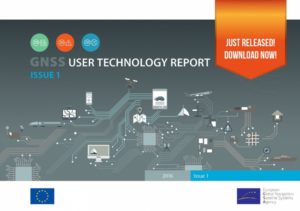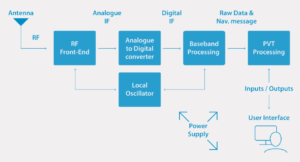
The report focuses on three key macrosegments:
- mass market solutions
- transport safety and liability-critical solutions
- high precision, timing and asset management solutions
DOWNLOAD the 2016 GNSS user technology report.
The 2016 GSA GNSS User Technology Report begins with a comprehensive overview of GNSS user technology. This is followed by a macrosegment analysis that focuses on receiver design, innovative signal processing techniques, changes that have an impact on antennas, and GNSS vulnerabilities – and how to mitigate them.
The Report also takes a closer look at how changes in user needs, GNSS systems, and the underlying technologies all impact receiver design. Specific developments and typical solutions for a given application area are also presented, including: Location Based Services, Agriculture, Transportation (Aviation, Maritime, Rail, Road), and Surveying and Timing. These applications are grouped within three macrosegments:
- Mass market consumer solutions: high volume chipsets typically used in smartphones, tablets and other consumer devices, along with emerging solutions for the Internet of Things (IoT), in-vehicle navigation, consumer unmanned aerial vehicles (UAVs), general aviation Visual Flight Rules (VFRs) and leisure maritime. These solutions are characterised by their need for a fast time to first fix and high availability, but not being very demanding in terms of accuracy.
- Transport liability-critical and safety-critical solutions: location solutions for Road User Charging, Emergency Caller Location (such as eCall), Advanced Driver Assistance, Smart Tachograph, Civil Aviation, Prosumer UAVs, Control Command and Signalling solutions in Rail, Ship Navigation in Maritime (including Vessel Traffic Management), and Anti-Collision systems. These applications are characterised by their need for more robust positioning and navigation information that is secured by integrity and authentication. Solutions usually must comply with safety requirements and standards.
- High precision, Timing and Asset Management solutions: Business to Business (B2B) technology solutions for tractor guidance, Variable Rate Technology in agriculture, geodesy and other surveying applications, all asset management solutions (e.g. container tracking, fleet management), and the timing and synchronisation solutions used by telecom operators, financial services and energy providers. These applications are characterised by their demand for accuracy in both position and time.
The Report’s final section provides a comprehensive overview of all positioning technologies, with a specific look at what lies beyond GNSS in the positioning landscape. A closer look is taken at such augmentation systems as Satellite Based Augmentation System (SBAS), Precise Point Positioning (PPP) solutions, other radio location technologies and non-radio positioning techniques.
The 2016 GSA GNSS User Technology Report was written with the contribution of leading GNSS receiver and chipset manufacturers. Its purpose is to serve as a valuable tool for planning and decision-making in regards to developing, purchasing and using GNSS user technology.

